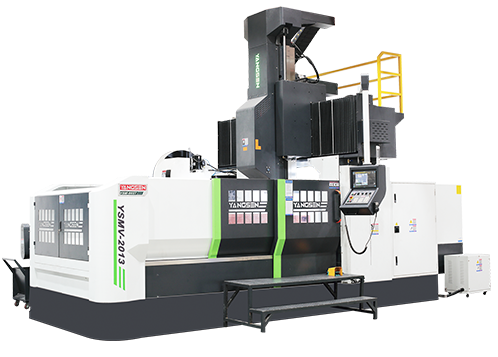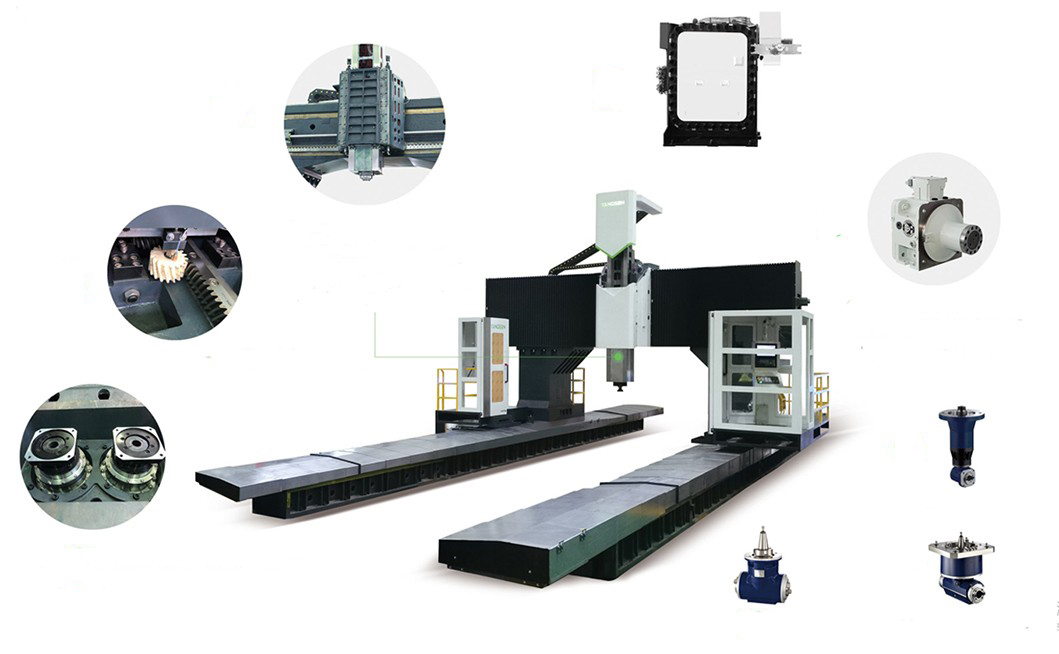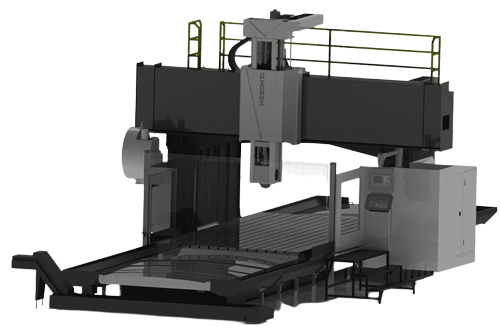Bridge-type CNC milling machines are the backbone of modern manufacturing industries, producing intricate products with the highest levels of precision and repeatability. Accuracy, precision, and speed are the only things that work in manufacturing processes. As the products become complex and tolerances tighter, the need for accurate, reliable, and efficient machining has increased.
CNC machines have revolutionized machinery parts production, allowing businesses to supply high-quality products efficiently and cost-effectively. With advanced control systems, powerful spindles, and robust construction, bridge-type CNC milling machines are workhorses of the industry, delivering the best performance and reliability.
These machines are the key to unlocking new levels of efficiency and quality in manufacturing. But what makes the CNC milling machine so special? How do they work? And what sets them apart from other milling machines?
We'll look closer at the bridge-type CNC milling machines and explore their features, benefits, and role in shaping the future.
Bridge-type CNC (computer numerical control) milling machines provide high-precision machining capabilities, allowing manufacturers to carry out complex operations quickly.
In CNC milling, automatic machines cut metals to shape them precisely. A CNC milling machine performs a machining process that uses a computer to control the cutting operations. It controls tool sequence, cutter, and spindle RPM and employs a rotating tool to cut materials.
In addition, milling machines of several axes allow intricate cutting. For dealing with simple materials, 3 axes (x, y, and z) of motion are used. Otherwise, five or more axes of motion manage complex milling processes.

Dating back to the 20th century when all machines were operated manually. In the late 1940 and early 1950, CNC milling machines were developed to perform automatic manufacturing operations. Early machines were used to punch paper tapes.
Today, it uses computers to store and execute instructions for the machine's movement. These machines use a gantry or bridge, which provides greater rigidity and stability. Also, the milling machine's design allows larger workpieces to operate more precisely.
Bridge-type CNC milling machines are highly automated and precision-driven machines. These are used for cutting, shaping, and drilling materials like metal, wood, and plastics. The primary components of CNC milling machines include:

The milling machine's frame provides support and rigidity to resist cutting forces generated during operations. The frame is designed to absorb and dampen vibrations and shocks. It controls the machine's major components, including the base, spindle, axes, and linear motion systems.
It's a stable foundation for frames, allowing machines to cut or shape metals at a proper level. A heavy-duty cast iron or steel material makes up the base, absorbing vibrations and preventing deflection.
Also, the base serves as a reservoir for coolant or lubricating fluids. It contains channels and grooves that collect and recycle these fluids, ensuring efficient and environmentally friendly operations.
A spindle is a rotating component holding a cutting tool and rotating at high speed to perform cutting operations. It's powered by a high-torque motor rotating in multiple directions to operate complex machinery functions.
Axes are linear motion systems that signal spindles to move in three directions - x, y, and z. These common axes correspond to horizontal, vertical, and depth movements. Precision ball screws, linear guides, and servo motors control axes to ensure precise and accurate movement.
Machines' computer numerical control system (CNC) controls CNC milling machines' axes, receiving instructions from a machine's programming language. These instructions dictate the movement and positioning of cutting tools, allowing precise and complex machining processes.
During machine operations, automatic tools change cutting tools quickly and efficiently. It has a magazine showing multiple tools and their use to move them into or out of the spindle.
ATC consists of a tool magazine storing multiple tools, and a tool changer picks and places it in the spindle. Then the controller manages the tool-changing process. The process is automatic, quick, and accurate, ensuring that milling operates at peak efficiency and productivity.
These systems are designed for high precision and accuracy, critical to performing functions. Linear motion systems allow precise motion of the spindle and table.
The control system includes a computer, software, and other electronics that programs and control machines. These systems enable the operator to input machine instructions and control the movement of the spindle and axes.
The equipment performs the processes in the CNC milling machines for sequencing, cutting, and refining materials.

Worktable is a flat surface on which a workpiece is mounted during machining. It's made of cast iron, moving in x and y directions to position the workpiece under the cutting tool. Also, it has T-slots for securing the workpiece with clamps or bolts.
It's placed below the worktable or on the knee, holding a table to support the workpiece and cutting tool. It moves in the x-axis direction. The machine's computer numerical control (CNC) system controls the saddle's speed and direction by receiving input from a pre-programmed tool path.
The knee is mounted on the machine's bed. Its vertical component facilitates the saddle via dovetail to move up and down in the z-direction. Its large, rectangular casting provides rigidity and stability for milling, raising, and lowering the spindle to adjust its thickness. It provides support and motion control for the saddle and workpiece.
A spindle is a rotating component holding a cutting tool and providing the translational and rotational speed and torque for cutting. An electric motor or power source drives the cutting process. The spindle has a variety of configurations, including belt-driven, direct-drive, or gear-driven designs.
Arbor is a cylindrical shaft to which all the tools are fixed. It's inserted into the spindle and locked into place with a drawbar. Arbor has a standard taper or interface that matches the milling machine's spindle. It allows quick, easy attachment and removal of an arbor and cutting tools.
A vertical component attached to the top of the column moves in the y direction. Also, it supports the spindle head and cutters, as the ram operates in vertical or angular milling machines.
A hydraulic or pneumatic system drives the ram, controlling its movement and position. Depending on the specific machine design, it has a range of motion, including vertical and horizontal movement.
Machine tools are devices used in manufacturing processes to shape, form or cut materials into specific shapes or sizes. These are the cutting tools used for machining the workpiece. Cutters are held in the arbor and rotated by a spindle to remove material from the workpiece. It includes end mills, drill bits, reamers, taps, and countersinks.
The operator interacting with the machine's control system is the interface. It includes a visual display, input devices like a keyboard or touch screen, and software that allows the operator to program the machine for specific machining operations. The interface sets up the machine, inputs the tools, and monitors the progress of the machining operations.
Bridge-type CNC milling machines use rotating cutting tools to remove materials to generate the desired end product shape. Here's a step-by-step breakdown of the CNC milling machines' working process:
Before cutting materials, the first step is to create a design or 3D model of the desired product through computer-aided design (CAD) software. It helps specify dimensions and tolerances to carry out machining operations properly.
Then the program converts the design into machine-readable code, automating the process using computer-aided manufacturing (CAM) software.
Secondly, workpieces are mounted on a milling machine table through clamps or vises. The table moves along the z axes to position workpieces at a desired height relative to the cutting tool.
Achieve an accurate workpiece setup through measuring tools, such as height gauges, dial indicators, and micrometers, to verify the position and alignment of the workpiece.
Thirdly, tool art up involves selecting, installing, and adjusting cutting tools to maintain optimal performance and accuracy. The cutting tool is placed in the machine's spindle. The tools rotate at high speeds and move along the three axes to create a shape with proper sequence.
Fourthly, when workpieces and tools are set, the machining process begins. The CNC control system reads the program and sends commands to the machine's linear motion system.
During milling, it passes the cutting tool and the programmed path to remove unwanted materials from the workpiece while it remains stationary. It performs processes manually or uses lathes, milling, and drilling machines.
Fifthly, after machining, workpieces require finishing operations, such as polishing, deburring, or painting, to show a refined look. Finishing enhances the quality and durability of a wide range of materials.
This process refines the material's surface to achieve desired texture, smoothness, or appearance. However, it removes imperfections, smoothens roughness, and polishes to a mirror-like finish.
Sixthly, engineers inspect the finished product to ensure it meets the required quality standards and specifications. It involves specialized equipment or comparing products to 3D models using a coordinate measuring machine (CMM).
By identifying defects, companies minimize waste, reduce costs and improve customer satisfaction.
Different milling methods generate the machine parts in various shapes and features on a workpiece. Have a look at the five types of milling:

Plain milling is the first type of CNC milling developed. It's a simple operation forming flat surfaces parallel to rotating axes. The milling cutter has teeth on its periphery to remove materials as the cutter rotates. Workpieces are mounted on a milling machine table and moved through the x and y axes to position them under the rotating cutter.
The vertical position of the milling machine table is adjusted to control the depth of the cut, while the milling machine spindle is tuned to direct feed rate. Thus, it produces a finished flat surface used as a reference for further machining operations.
The cutting tool creates flat surfaces on large parts, such as engine blocks and machine bases, perpendicular to the cutter's rotating axes. The face milling cutter possesses a circular pattern on its periphery. The cutting tool rotates and cuts the material from the workpiece in a circular motion.
Workpiece is mounted on a spindle lowered to the workpiece surface. The spindle and cutter rotate at high speed, and the milling table moves in x and y axes to feed the workpiece to the rotating tool.
It involves machining a workpiece at a specific angle to produce angular surfaces for removing materials. This process uses a milling cutter with an angled cutting edge to form chamfers and bevels.
Angular milling requires precise positioning and control of the machine and cutting tool. Even carefully selecting cutting parameters is essential to ensure an efficient machining process.
Commonly, machine parts with angled surfaces form through angular milling. For example, automotive components, turbine blades, and aerospace parts.
Machining a workpiece to a specific shape using a milling cutting tool is called form milling. Milling cutters arrange the edges to match the desired shape or form of the workpiece. The cutter rotates and cuts the material under the rotating tool in a specific pattern.
Form milling produces complex shapes and contours on a workpiece, such as gears, cams, and molds.
Using milling cutters (set up on a horizontal arbor) to separate materials increases material production. Two milling cutters are mounted on a single arbor and machines multiple workpiece surfaces simultaneously.
Often, it produces large batches of identical parts with multiple features, such as holes, keyways, and slots, where it's efficient to machine multiple parts rather than individual ones.
Evaluate specific factors to ensure your machine accommodates desired workpieces. Also, keep the budget constraints into account.
When selecting bridge-type CNC milling machines, consider the following factors:
Machines' table size, spindle movement, and work area should accommodate and match the size and complexity of the workpiece under the machining process.
Milling machines should produce parts with the required accuracy and precision. It includes the machine's repeatability, spindle runout, and positioning.
Milling machines operate cutting speeds and feed rates to produce parts without compromising the quality of the finished product.
A powerful spindle can handle machined materials. The spindle power rating determines the maximum horsepower that the spindle delivers to the cutting tool of the milling machine.
Milling machines tool changer helps change tools during the machining process. It reduces downtime and increases productivity.
The control system should be easy to use and has the necessary features to program and control machines. It can import CAD or CAM files and creates customized programs.
When buying a milling machine, keep your budget in mind. Also, opt for the CNC machine providing a good return on investment for specific machining processes.
Technological advancements have led to increased precision and productivity. 5-axis and 6-axis milling machines operate complex functions, while adaptive control systems adjust cutting parameters in real time.
Real-time monitoring systems detect issues before they cause damage. Its integration with CAD/CAM software streamlines the manufacturing process.
Maintenance is essential for the longevity and proper performance of CNC milling machines. Perform maintenance tasks every week to keep it lubricated and cleaned regularly. Address common issues to avoid further damage.
Understand how bridge-type CNC milling machines can help manufacturers operate their processes quickly and efficiently.
CNC milling machines handle a wide range of materials and perform machining operations. It processes materials such as metals, wood, plastics, and composites of varying hardness and shapes. These machines execute drilling, tapping, contouring, and engraving through various cutting tools.
One of the significant advantages to manufacturers, they can set up a single machine to produce a wide range of products, reducing the need for multiple machines and equipment. It offers manufacturing facilities, saving space and reducing capital investments and maintenance costs.
Furthermore, milling machines allow quick retooling and reprogramming, enabling manufacturers to respond to changes in product design. This flexibility alerts companies to be agile in this competitive era.
CNC gantry-type milling machines possess spindles and feed rates to improve efficiency in cutting processes. It has the potential to maintain the structure's rigidity when cutting materials.
Than ordinary machine tools, CNC performs powerful cutting of materials faster in auxiliary movement, consuming less maneuvering time.
The machining center occupies an automatic tool changer, feeding devices, and spindles to carry multiple processes simultaneously. It reduces the logistics and turnover time of the manufactured and finished products.
Computer-controlled cutting and precise linear motion attribute high processing accuracy. Cutting tools move with the linear motion system, capable of achieving a high degree of accuracy.
CNC milling machines feature advanced feedback systems that provide real-time information to the control system. It adjusts the machining process to maintain accuracy and precision. Feedback systems include sensors that measure cutting forces, temperature, and vibration, allowing machines to adjust control processes.
Even though CNC milling machines and their equipment are costly, small batch production reduces processing time and cost. High versatility and stability in the quality prevent waste generation, helping achieve high output.
In addition to this, CNC machines support processes, manage logistics, and lower management bills. Reduction in adjustment and inspection costs.
In CNC-type milling machines, all the heavy processes are performed automatically. Labor only loads and unloads the workpieces, observes tools, measures processes, selects programs, and starts the machine. Operators don't have to perform manual operations, so labor intensity and risk of errors are reduced.
In traditional milling machines, the operator adjusts the position and speed of the cutting tool manually, which requires a high degree of skill and experience. However, CNC milling machines execute automated processes and control machines through computers.
CNC milling machines run continuously, requiring minimal human intervention. It allows manufacturers to optimize their workforce, minimizing labor costs.
Below lists some more benefits of using bridge-type CNC milling machines:
● Offer high precision and accuracy
● Increase productivity and efficiency
● Reduce time and labor
● Reduce operator fatigue
● Improve safety
Bridge-type CNC milling machines are used in various industries, including aerospace, automotive, medical, and electronics. These machines produce materials with fewer tolerances, making them essential in the production of parts.
● Aerospace
● Automotive
● Medical
● Electronics
● Furniture
● Mold & Die making
Advances in automation and artificial intelligence are making these machines even more efficient and productive. They play an increasingly important role in the production of materials in a range of industries.
Also, the development of new materials and technologies requires specialized machining capabilities.
In addition, CNC milling machines impact the aerospace industry. These machines manufacture aircraft components to ensure safety. Double-column machines are ideal for this industry since they create complex shapes with accuracy and repeatability.
Bridge-type milling machines are gaining popularity in the medical industry, requiring surgical instruments, prosthetics, and orthopedic implants with accurate specifications.
As the demand for electric vehicles rises, the automotive industry uses bridge-type CNC milling machines for manufacturing engines and transmission parts.
Computer-aided manufacturing (CAM) software is becoming more sophisticated and intuitive. The automation process also reduces the need for manual labor, increasing efficiency and productivity.
Bridge-type CNC machines are a true engineering marvel, transforming raw materials into highly specific complex components. Its advanced technology has a robust design and unparalleled accuracy, making it a crucial tool for manufacturers across industries.
Moreover, its ability to handle various materials, complex geometries, and details has made it a go-to solution for precision manufacturing.
So, if you want to take your manufacturing capabilities to the next level, there's no better choice than bridge-type CNC milling machines.